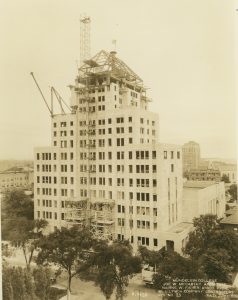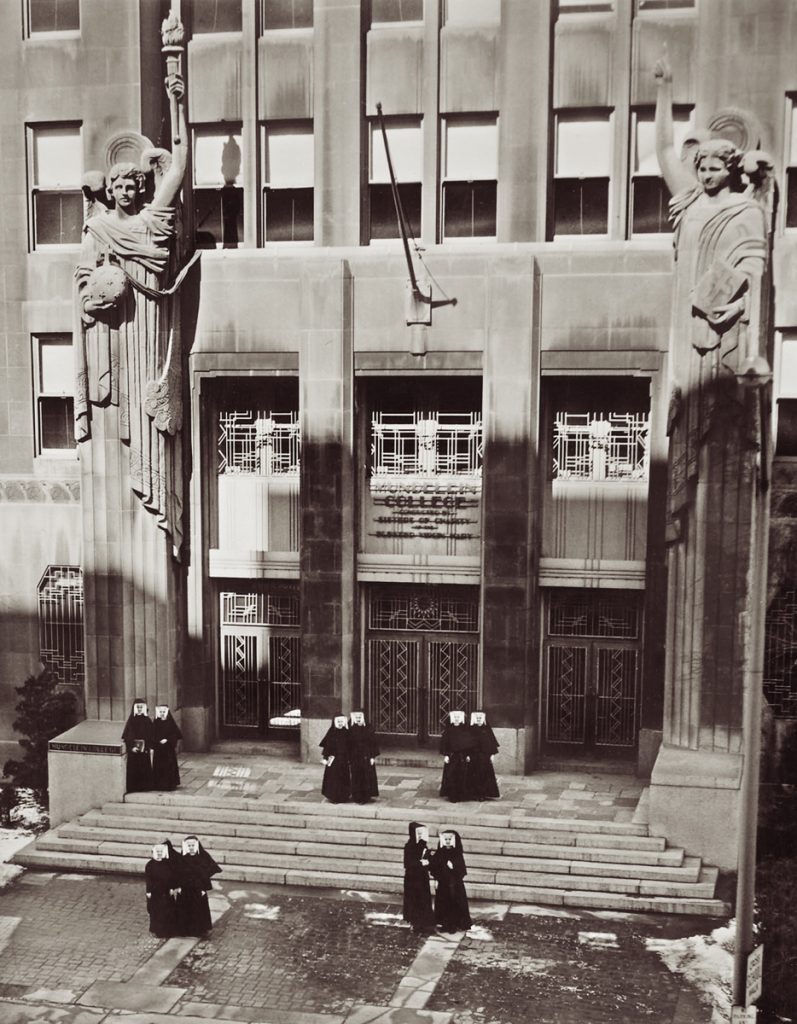
Mundelein College skyscraper construction
I had plunged into the waters of religious archives as the result of research in women’s history in Chicago. One particular episode had to do with the historical research I contributed to my colleague Ellen Skerrett’s curation of the B. V. M. section of the Loyola University Chicago’s Art Museum exhibition “Crossings and Dwellings: Restored Jesuits, Women Religious, American Experience, 1814-2014.” Having studied immigrant neighborhoods in the city, I knew that Catholic women—both lay and religious—held the key to a larger story of community building, social service, and education. Catholic sisters were, indeed, “Sister Builders” of the cityscape in brick and mortar and of the social infrastructure that held urban centers together. However, as Ellen and I soon found out, Catholic women religious archives presented challenges for the historian. This became crystal-clear when we found scant information about Mother Isabella Kane, B. V. M. , an important leader during the expansion of higher education for women in Chicago and, as we found, mainly responsible for the conception and implementation of Mundelein College. I had spent several nights and days at Mount Carmel, Dubuque, Iowa, the motherhouse of the Sisters of Charity Blessed Virgin Mary—the BVM, I knew what little biographical information existed for many of the women of the congregation. This was, by the way, the congregation of predominantly Irish women, who first set foot in Philadelphia, City of Brotherly Love, only to barely escape the burning of their convent and school during an anti-Catholic riot in 1844, headed to Iowa; here, on the banks of the Mississippi, they established a foothold in the vast new continent; from this perch, they sent forth sister-teachers and sister-builders in many parts of the United States. In Chicago, they developed high schools—St. Mary and Immaculata– and designed and built a modern skyscraper college: Mundelein College. Mother Kane was the daughter of an illiterate Irish immigrant woman, widowed and bringing up her family on Chicago’s Near West Side in the Holy Family parish. Sent to parochial school, the young girl learned to read and more than read, she learned to think, to draw and appreciate art and architecture, and, eventually, to be the intellect behind the conception of a skyscraper college for Catholic women in Chicago. How did we find out? Often reading between the lines– -finding a “little black book” – brought to our attention by the archivist at Mount Carmel, and also, studying Mother Kane’s correspondence with Cardinal Mundelein, with the architect chosen initially for the work, and with an expert from Harvard University who was both a designer and an historian of heraldry. What we found was evidence that this first generation American Catholic woman had negotiated the buying of property, the incorporation of the college, and had significantly influenced the architectural style, the iconic external and internal decorations, the sculpture and symbolic statuary of this 20 th century innovation, a skyscraper building housing a woman’s college centrally located in, at the time, the second largest city in the United States which had a large Catholic population in need of higher education. She knew it was time for women to be educated in the professions, for Catholic women religious to have greater access to higher education for themselves as teachers and as students. Our sources were not “personal” since Isabella Kane did not write memoirs or even one or two revealing, intimate letters to close friends or kin! To learn about her aesthetics and her educational goals we had to plumb her “black book” which did not directly address such issues but had her administrative notes; we had to piece together her ideas from her business correspondence with architects, the church hierarchy, real estate people, and an expert in heraldry. Ellen Skerrett and I were able to find blueprints that revealed the kinds of changes Mother Kane instigated in design of the building, establishing her agency in the creation and implementation of the B.V.M.’s dream of higher education for Catholic women.
Rima Lunin Schultz
Advisor to the Jane Addams Papers Project and Independent Historian

Angels in place, 1930
